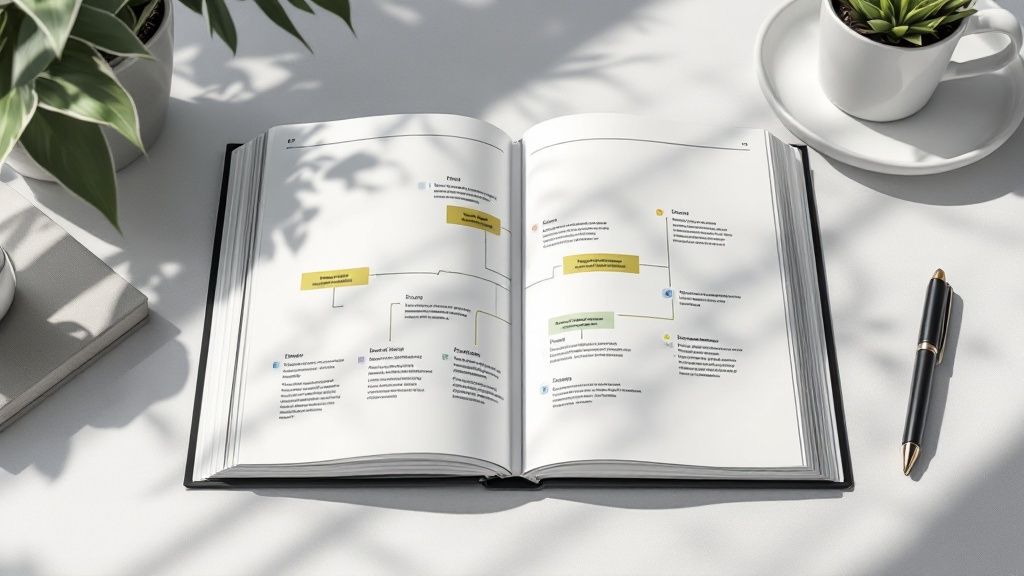Unleash Your Sales Team's Potential
Want to empower your sales team to close more deals and boost revenue? This article delivers seven powerful sales enablement strategies to elevate your sales organization. Learn how to optimize content management, implement effective training programs, integrate your tech stack, develop winning playbooks, leverage data analytics, improve cross-functional collaboration, and provide just-in-time learning. These sales enablement strategies are essential for building stronger customer relationships and driving consistent growth, whether you're a solo freelancer or an enterprise organization.
1. Content Management and Distribution
Effective sales enablement hinges on providing your sales team with the right resources at the right time. Content Management and Distribution is a crucial sales enablement strategy that addresses this need by creating, organizing, and delivering relevant sales content to salespeople precisely when they need it. This strategy ensures sales teams have easy access to up-to-date, buyer-focused materials that support every stage of the sales process, from initial prospecting and lead qualification to closing deals and nurturing existing clients. By streamlining access to critical information, this strategy empowers sales teams to be more efficient, consistent, and ultimately, more successful.

This approach involves several key components working together. It starts with a centralized content repository, acting as a single source of truth for all sales materials. This repository is then organized using a system of tagging and categorization, allowing for easy searchability and retrieval. The system also facilitates real-time content updates, ensuring that salespeople are always working with the most current information. Furthermore, usage analytics and tracking provide valuable insights into which content pieces are most effective, allowing for data-driven content optimization and continuous improvement. Support for multi-format content (presentations, videos, case studies, etc.) caters to diverse learning styles and selling situations. Robust search functionality makes it easy for sales reps to find what they need quickly, and content personalization capabilities allow for tailoring materials to specific buyer personas or individual prospects.
The benefits of a well-executed Content Management and Distribution strategy are numerous. It significantly reduces the time salespeople spend searching for materials, allowing them to focus more on selling. It also ensures consistent messaging across the entire sales team, reinforcing brand identity and improving the overall buyer experience. Moreover, it improves content utilization rates, maximizing the return on investment in content creation. Data-driven content optimization, fueled by usage analytics, enables the continuous improvement of sales materials and the identification of high-performing assets. Finally, it supports faster onboarding of new sales reps by providing them with immediate access to the resources they need to get up to speed quickly.
However, implementing this strategy also presents some challenges. It requires a significant initial investment in content creation and organization. Ongoing maintenance and updates are necessary to keep the content fresh and relevant. There's also a risk of overwhelming users with too many options if the repository isn't well-organized. Finally, proper training is essential for effective adoption and to ensure that sales teams utilize the system to its full potential.
Examples of successful implementation abound. Salesforce leverages Highspot to manage over 10,000 content assets, ensuring their global sales team has consistent access to the latest resources. Microsoft implemented Seismic to organize sales playbooks and battle cards, empowering their sales force with targeted information for specific competitive situations. HubSpot utilizes its content library with buyer persona-specific materials, allowing their sales team to personalize their outreach and resonate more effectively with prospects. These examples showcase the power of this strategy across various scales and industries.
To effectively implement a Content Management and Distribution strategy, consider these actionable tips:
- Start with an audit of your existing content to identify gaps and redundancies. This will help you prioritize content creation efforts and ensure you're addressing the most critical needs of your sales team.
- Implement consistent naming conventions and tagging. This will make it easier for salespeople to search for and locate the materials they need.
- Create content feedback loops with sales teams. Regularly solicit feedback from your sales team to understand what's working, what's not, and what kind of content they need more of.
- Use analytics to identify the most effective materials. Track content usage and engagement to understand which pieces are resonating with buyers and driving results.
- Regularly purge outdated content. Keeping your content library clean and up-to-date will prevent confusion and ensure that salespeople are always using the most current information.
This strategy deserves a top spot on any list of sales enablement strategies due to its direct impact on sales team efficiency and effectiveness. By providing salespeople with the tools and resources they need to succeed, Content Management and Distribution empowers them to close more deals and drive revenue growth. Companies like Salesforce, Highspot, Seismic, and Showpad have popularized this approach, demonstrating its value in today's competitive sales landscape. Learn more about Content Management and Distribution and discover how this powerful sales enablement strategy can benefit your organization. This strategy is particularly relevant in today’s digital-first world where buyers are more informed than ever. Providing your sales team with readily accessible, relevant, and high-quality content is crucial for engaging prospects effectively and winning deals. This makes content management and distribution a cornerstone of any successful sales enablement strategy.
2. Sales Training and Coaching Programs
Sales training and coaching programs represent a systematic approach to developing and honing sales skills through structured learning programs, ongoing coaching, and consistent performance feedback. This sales enablement strategy focuses on the continuous improvement of sales capabilities, spanning from fundamental selling skills to advanced techniques for handling complex deals and negotiations. It's a cornerstone of effective sales enablement, ensuring your team is equipped with the knowledge and skills to succeed in today's dynamic market.

These programs often incorporate a variety of features designed to cater to diverse learning styles and needs. Competency-based training modules ensure a structured approach to skill development, while role-playing and simulation exercises provide practical experience in a safe environment. One-on-one coaching sessions offer personalized guidance and feedback, whereas peer learning opportunities facilitate knowledge sharing and collaboration. Performance tracking and assessment tools help monitor progress and identify areas for improvement. Microlearning formats deliver bite-sized learning content, making it easy for sales professionals to consume information on the go, further enhanced by mobile-accessible content.
This multifaceted approach makes sales training and coaching programs a vital sales enablement strategy for organizations of all sizes, from solo sales professionals and freelancers to enterprise organizations. Small-to-medium sized B2B sales teams, marketing and lead generation agencies, and sales operations and enablement managers can all benefit from implementing a robust training program.
Why Sales Training and Coaching Programs Deserve Their Place in the List
In the competitive landscape of sales, continuous learning is no longer optional—it's essential. Training and coaching programs provide a framework for consistent skill development, ensuring your team stays ahead of the curve and adapts to evolving buyer behaviors. This proactive approach fosters a culture of learning and improvement, ultimately driving better sales performance and boosting revenue. For new hires, these programs reduce ramp time, allowing them to contribute effectively sooner. Experienced sales professionals also benefit from ongoing training, refining their skills and learning new techniques to tackle complex sales challenges.
Benefits and Drawbacks
The advantages of implementing robust sales training and coaching programs are numerous. They improve overall sales performance, reduce ramp time for new hires, increase sales team confidence and competence, and create a standardized sales approach across the organization. Furthermore, investing in employee development enhances employee retention and fosters a culture of continuous learning.
However, it's important to acknowledge the potential drawbacks. These programs can be time-intensive for both trainers and trainees, requiring a dedicated commitment. There are often high upfront costs for program development and implementation. Measuring the return on investment (ROI) can also be challenging, particularly in the initial stages. Finally, consistent management commitment is crucial for long-term success.
Examples of Successful Implementation
Several organizations have successfully implemented sales training and coaching programs, demonstrating the power of this strategy. IBM's sales certification program with role-specific tracks provides tailored training for different sales roles within the organization. Oracle University's comprehensive sales training curriculum offers a wide range of courses covering various sales methodologies and techniques. Salesforce Trailhead provides engaging and interactive training for CRM and sales methodology. LinkedIn Learning also offers a vast library of sales skills development programs accessible to individuals and organizations.
Actionable Tips for Implementation
To maximize the effectiveness of your sales training and coaching programs, consider these tips: Align training with specific business outcomes to ensure relevance and impact. Use spaced repetition techniques for better knowledge retention. Incorporate real customer scenarios into training exercises for practical application. Provide just-in-time learning resources to support sales professionals in real-time. Finally, focus on measuring behavioral changes resulting from training, not just knowledge acquisition.
When and Why to Use This Approach
Sales training and coaching programs are particularly valuable when introducing new products or services, implementing new sales methodologies (like SPIN Selling popularized by Neil Rackham or the Challenger Sale by Matthew Dixon), or targeting new market segments. They are also essential for onboarding new sales hires and for addressing performance gaps within the existing sales team. By investing in ongoing training and coaching, you equip your team with the tools they need to succeed, driving consistent growth and achieving your sales objectives. Learn more about Sales Training and Coaching Programs to further enhance your understanding of how these programs can benefit your sales organization. Influential figures like Dale Carnegie and Sandler Training further underscore the enduring importance of sales training in achieving lasting success.
3. Technology Stack Integration
Technology stack integration is a crucial sales enablement strategy that focuses on strategically aligning and integrating various sales technologies to create a seamless and efficient workflow. This approach connects essential tools like Customer Relationship Management (CRM) systems, sales automation platforms, communication tools (email, phone, video conferencing), and analytics platforms to eliminate data silos, reduce manual work, and provide comprehensive insights into the sales process. By streamlining these disparate systems, sales teams can operate more efficiently, personalize their outreach, and ultimately close more deals.

This strategy is essential for modern sales enablement because it directly addresses the challenges of managing information across multiple platforms. Sales professionals often juggle various tools, leading to fragmented data, wasted time, and missed opportunities. Technology stack integration solves this by creating a central hub for all sales-related information and automating key processes. For example, a lead captured through a marketing automation platform can automatically be routed to the correct sales representative in the CRM, triggering a personalized email sequence and notifying the sales rep to follow up. This level of automation and data synchronization empowers sales teams to work smarter, not harder.
Features of a well-integrated technology stack include CRM integration as the central hub, API connections between platforms for seamless data flow, single sign-on capabilities for simplified access, a unified data architecture for consistent reporting, automated workflow triggers to streamline processes, cross-platform reporting for holistic performance analysis, and mobile synchronization to empower sales teams on the go.
The benefits of technology stack integration are numerous. Eliminating data silos and duplicate entry saves time and improves data accuracy. A 360-degree customer view allows for personalized interactions and targeted campaigns. Increased sales team productivity is achieved through automation and streamlined workflows. Better forecasting and reporting become possible with consolidated data, enabling data-driven decision-making. Finally, reducing technology adoption friction through single sign-on and intuitive integrations encourages wider usage and maximizes the return on investment in sales technology.
However, there are also potential drawbacks. Implementing and maintaining such integrations can be complex and require technical expertise. Integration costs can be substantial, especially for larger organizations with extensive technology stacks. Security vulnerabilities are a concern, as connecting multiple systems requires careful attention to data protection. Over-dependence on technology can also be a risk, as technical issues can disrupt workflows and hinder productivity.
Successful examples of technology stack integration include HubSpot's integrated sales, marketing, and service platform, Salesforce's extensive AppExchange ecosystem, Microsoft's integration of Dynamics 365 with Office 365, and Zoom's integration with major CRM platforms. These examples demonstrate the power of connecting various tools to create a unified sales ecosystem.
When considering technology stack integration, start with core integrations before expanding to more specialized tools. Ensuring data quality before integration is critical to avoid propagating errors across systems. Provide adequate user training on integrated workflows to encourage adoption and maximize the benefits. Regularly audit and optimize integrations to ensure they continue to meet evolving business needs. Finally, plan for scalability from the beginning to accommodate future growth and avoid costly rework. Learn more about Technology Stack Integration and explore how integrating specific tools can enhance your sales process.
This strategy is particularly valuable for solo sales professionals and freelancers looking to streamline their operations, small-to-medium sized B2B sales teams seeking to improve efficiency and collaboration, marketing and lead generation agencies aiming to connect marketing efforts with sales outcomes, sales operations and enablement managers striving to optimize the sales process, and enterprise organizations seeking fully managed outreach services to enhance their sales performance. By leveraging technology stack integration as a key sales enablement strategy, organizations of all sizes can empower their sales teams to achieve greater success.
4. Sales Playbook Development
Sales playbook development is a crucial sales enablement strategy that focuses on creating comprehensive, standardized guides outlining proven sales processes, methodologies, and best practices. These playbooks act as essential reference materials, empowering sales teams to execute effective selling strategies consistently while preserving valuable organizational knowledge. A well-crafted playbook ensures everyone operates from the same foundation, leading to a unified and more effective sales approach. This is particularly beneficial for onboarding new team members and scaling sales operations while maintaining a consistent customer experience. It's an investment in building a repeatable, predictable sales engine.

A robust sales playbook typically includes step-by-step process documentation, guidance for various sales situations, frameworks for handling objections, competitive positioning strategies, pre-written email and call templates, discovery question libraries, and clearly defined success metrics and KPIs. Think of it as a central repository of best practices and proven tactics that equip your sales team to navigate the sales cycle effectively, from initial contact to closing the deal. Developing a sales playbook requires a structured approach to organizing and delivering sales content. Leveraging creative project management techniques can streamline this process, ensuring the final product is well-organized, accessible, and effective. These techniques help in efficiently managing tasks, timelines, and resources related to content creation. Source: Creative Project Management Tips to Boost Your Team’s Success from Creativize.
Several successful companies leverage sales playbooks as a key part of their sales enablement strategies. Outreach.io uses sequence playbooks tailored to different buyer personas, enabling their sales team to personalize outreach efforts effectively. Gong leverages conversation intelligence to inform their playbooks, providing data-driven insights into winning sales conversations. SalesLoft utilizes cadence playbooks for various sales scenarios, ensuring consistent follow-up and engagement. Slack also employs product-specific sales playbooks, equipping their sales teams with the knowledge to effectively position and sell their diverse product offerings.
Why Sales Playbook Development Deserves Its Place Among Sales Enablement Strategies:
In the competitive landscape of modern sales, consistent execution and efficient onboarding are critical for success. Sales playbook development addresses these needs directly. By standardizing the sales approach across the team, playbooks ensure everyone is on the same page, following proven methodologies. This drastically reduces the ramp-up time for new hires, allowing them to contribute quickly. Moreover, playbooks safeguard institutional knowledge, ensuring that valuable insights and best practices aren't lost when team members depart. Finally, a consistent approach translates to a more consistent and positive customer experience, which can greatly impact customer satisfaction and retention.
Pros and Cons of Sales Playbook Development:
Pros:
- Standardizes sales approach: Ensures consistent execution of best practices across the team.
- Accelerates new hire onboarding: Equips new team members with the knowledge and tools to contribute quickly.
- Preserves institutional knowledge: Captures and retains valuable sales insights and experiences.
- Improves consistency in customer experience: Provides a unified and predictable customer journey.
- Enables scalable sales operations: Facilitates growth by providing a structured framework for sales activities.
Cons:
- Can become outdated quickly: Requires regular updates to reflect market changes and evolving buyer behavior.
- May reduce sales creativity and adaptability: Over-reliance on playbooks can stifle individual initiative and flexibility.
- Time-consuming to create and maintain: Developing and updating comprehensive playbooks requires significant effort.
- Risk of becoming too rigid or prescriptive: Playbooks should serve as guides, not strict scripts, allowing for adaptability in individual sales situations.
Actionable Tips for Sales Playbook Development:
- Involve top performers in playbook creation: Leverage their expertise and insights to capture best practices.
- Keep playbooks concise and actionable: Focus on clear, practical guidance that sales teams can readily apply.
- Update regularly based on market feedback and performance data: Ensure playbooks remain relevant and effective.
- Include real examples and case studies: Demonstrate successful implementation of the strategies outlined.
- Make playbooks easily searchable and accessible: Ensure sales teams can quickly find the information they need.
Sales playbook development is a powerful sales enablement strategy that provides structure, consistency, and efficiency to sales operations. By implementing these best practices and continually refining your playbooks based on performance data and market trends, you can empower your sales team to achieve greater success. This strategy is particularly valuable for solo sales professionals, small to medium-sized B2B sales teams, marketing and lead generation agencies, sales operations and enablement managers, and even large enterprise organizations seeking a structured approach to outreach.
5. Data-Driven Performance Analytics
In today's competitive sales landscape, gut feelings and anecdotal evidence are no longer sufficient for driving consistent growth. Effective sales enablement strategies must incorporate data-driven performance analytics, a systematic approach to collecting, analyzing, and applying sales data to optimize performance, identify trends, and make informed decisions. This crucial strategy leverages various metrics and Key Performance Indicators (KPIs) to provide actionable insights that fuel continuous improvement in sales effectiveness, securing its place as a core component of any modern sales enablement program.
Data-driven performance analytics transforms raw sales data – everything from call logs and email open rates to deal progression and revenue generated – into a powerful tool for understanding what works, what doesn't, and how to improve. This approach moves beyond simply reporting on past performance; it empowers sales teams to predict future outcomes, identify potential roadblocks, and proactively adjust their strategies for maximum impact. Whether you're a solo sales professional, part of a small B2B sales team, or a large enterprise organization, leveraging data-driven insights is essential for achieving sustainable success.
How it Works:
The core of data-driven performance analytics lies in a continuous cycle of data collection, analysis, and action. This process typically involves the following steps:
-
Data Collection: Implementing tools and processes to capture relevant sales data from various sources, including CRM systems, marketing automation platforms, sales engagement tools, and website analytics.
-
Data Processing and Analysis: Using analytical tools and techniques to clean, organize, and analyze the collected data. This might involve calculating key metrics like conversion rates, average deal size, sales cycle length, and customer lifetime value.
-
Insight Generation: Identifying patterns, trends, and correlations within the data to uncover actionable insights. This is where the "so what?" of the data becomes clear – revealing, for example, which marketing channels generate the highest quality leads, which sales activities correlate with higher win rates, or which stages of the sales pipeline present the biggest bottlenecks.
-
Action and Optimization: Implementing changes based on the insights gained, such as refining sales messaging, adjusting lead qualification criteria, or providing targeted sales training.
-
Monitoring and Iteration: Continuously tracking the impact of the implemented changes and iterating the process to further optimize performance.
Features and Benefits of Data-Driven Performance Analytics:
Several features make data-driven performance analytics a powerful tool:
- Real-time Dashboard Reporting: Provides up-to-the-minute visibility into key sales metrics, enabling quick identification of emerging trends and potential issues.
- Predictive Analytics Capabilities: Uses historical data and statistical modeling to forecast future sales performance and identify potential risks and opportunities.
- Activity-Based Metrics Tracking: Monitors and analyzes sales activities like calls, emails, and demos to understand their impact on sales outcomes.
- Pipeline Health Monitoring: Provides a clear view of the sales pipeline, identifying potential bottlenecks and areas for improvement.
- Individual and Team Performance Comparisons: Allows for objective evaluation of sales performance and identification of top performers and areas for coaching.
- Conversion Rate Analysis: Pinpoints areas where leads are being lost in the sales funnel and provides insights for improving conversion rates.
- Revenue Attribution Modeling: Determines which marketing channels and sales activities are most effective at generating revenue.
These features translate into several tangible benefits, including:
- Enables data-driven decision making: Moves sales strategy beyond guesswork and intuition, allowing for informed decisions based on concrete evidence.
- Identifies performance improvement opportunities: Highlights areas where sales processes and individual performance can be optimized.
- Provides early warning signals for pipeline issues: Allows for proactive intervention to address potential problems before they impact revenue.
- Supports accurate forecasting: Provides more reliable sales forecasts based on historical data and current trends.
- Facilitates objective performance evaluations: Provides a fair and transparent framework for evaluating individual and team performance.
Examples of Successful Implementation:
Companies like Salesforce (with Einstein Analytics), Gong, Tableau, and Microsoft (with Power BI) offer powerful solutions for implementing data-driven performance analytics. Salesforce Einstein Analytics, for instance, provides AI-powered insights that can predict which deals are likely to close, identify at-risk accounts, and suggest next best actions for sales reps. Gong uses conversation intelligence to analyze sales calls and identify winning behaviors.
Tips for Effective Implementation:
- Focus on leading indicators, not just lagging metrics: While lagging indicators (e.g., revenue generated) are important, leading indicators (e.g., number of qualified leads) provide more actionable insights for improving future performance.
- Establish data governance standards early: Ensure data quality and consistency by establishing clear data entry and management procedures.
- Provide context and interpretation with raw data: Data alone is not enough; provide context and interpretation to make the data meaningful and actionable.
- Use visualization to make data more accessible: Charts, graphs, and dashboards make data easier to understand and digest.
- Create actionable insights, not just reports: Focus on generating insights that can be directly translated into specific actions to improve sales performance.
Pros and Cons:
While data-driven performance analytics offers numerous benefits, it's crucial to acknowledge the potential downsides:
Pros: Enables data-driven decision making, identifies performance improvement opportunities, provides early warning signals, supports accurate forecasting, facilitates objective performance evaluations.
Cons: Requires consistent data quality, can lead to over-analysis paralysis, may overemphasize metrics at the expense of relationship building, requires analytical skills and training.
By carefully considering these pros and cons and implementing the strategies outlined above, sales organizations of all sizes can leverage the power of data-driven performance analytics to achieve significant and sustainable improvements in sales effectiveness.
6. Cross-Functional Collaboration: Breaking Down Silos for Sales Enablement
Cross-functional collaboration, a cornerstone of effective sales enablement strategies, involves strategically aligning sales with other customer-facing departments like marketing, customer success, product development, and even finance. This approach dismantles organizational silos, fostering a unified customer experience and maximizing revenue potential. By ensuring all teams work towards common goals, businesses can create a cohesive and efficient system that benefits both the customer and the bottom line. This strategy is particularly crucial in today's complex B2B landscape, where buyers expect seamless interactions and personalized experiences.
How Cross-Functional Collaboration Works:
At its core, cross-functional collaboration revolves around shared understanding, communication, and coordinated action. This means establishing shared goals and metrics, implementing regular cross-team meetings and joint planning sessions, integrating communication channels, sharing customer insights, coordinating customer touchpoints, and even implementing cross-functional training programs. Think of it as creating a unified front where every department contributes its expertise to nurture leads and close deals. Marketing might generate qualified leads, sales nurtures and converts them, customer success ensures ongoing satisfaction and identifies upsell opportunities, and product development incorporates customer feedback to improve offerings.
Real-World Examples of Successful Implementation:
Several companies have successfully implemented cross-functional collaboration as part of their sales enablement strategies:
- HubSpot's "Smarketing": HubSpot pioneered the concept of "smarketing," a tight alignment between sales and marketing teams. This approach emphasizes shared goals, metrics, and communication, leading to more qualified leads and higher conversion rates.
- Adobe's Revenue Operations Team: Adobe utilizes a revenue operations team structure, bringing together sales, marketing, and customer success under one umbrella. This centralized approach streamlines processes and ensures all revenue-generating activities are aligned.
- Slack's Customer Success and Sales Collaboration: Slack fosters close collaboration between its customer success and sales teams. Customer success managers identify expansion opportunities within existing accounts and seamlessly hand them off to sales representatives.
- Zoom's Integrated Go-to-Market Approach: Zoom's success is partially attributed to its integrated go-to-market strategy, where product development, marketing, sales, and customer success work in lockstep to deliver a consistent and compelling customer journey.
Actionable Tips for Implementing Cross-Functional Collaboration:
Implementing successful cross-functional collaboration requires a deliberate and structured approach. Consider these actionable tips:
- Establish Shared KPIs and Success Metrics: Ensure all teams are working towards the same goals by defining and tracking shared key performance indicators. This creates accountability and fosters a sense of collective ownership.
- Create Regular Communication Cadences: Implement regular cross-team meetings, joint planning sessions, and shared communication channels (e.g., Slack channels, project management software) to facilitate open communication and information sharing.
- Use Collaborative Tools and Platforms: Leverage technology to support collaboration. CRM systems, project management tools, and communication platforms can help teams stay connected and work together efficiently.
- Document and Share Customer Insights Across Teams: Create a centralized repository for customer data and insights, accessible to all relevant departments. This ensures everyone has a 360-degree view of the customer and can personalize their interactions accordingly.
- Celebrate Joint Successes and Learnings: Recognize and celebrate achievements as a cross-functional team. This reinforces the value of collaboration and motivates continued cooperation.
Pros and Cons of Cross-Functional Collaboration:
While cross-functional collaboration offers significant advantages, it's essential to be aware of potential challenges:
Pros:
- Improves lead quality and conversion rates
- Creates a seamless customer experience
- Increases customer lifetime value
- Reduces internal friction and conflicts
- Enhances organizational efficiency
Cons:
- Requires cultural change and buy-in
- Can slow decision-making processes in the initial stages
- May blur accountability lines if not managed properly
- Needs strong leadership coordination
When and Why to Use This Approach:
Cross-functional collaboration is particularly beneficial for organizations experiencing siloed operations, inconsistent customer experiences, or missed revenue opportunities. If your sales team struggles with lead quality, deals stall due to internal miscommunication, or customer churn is high, implementing a cross-functional approach can address these challenges. This strategy is highly relevant for B2B businesses, particularly those with complex sales cycles and multiple customer touchpoints. From solopreneurs partnering with freelancers to large enterprises, adopting a collaborative mindset can significantly enhance sales enablement efforts and drive business growth. By breaking down traditional departmental barriers and fostering a unified approach, organizations can create a more efficient, customer-centric, and ultimately, more profitable sales process.
7. Just-in-Time Learning and Support
In today's fast-paced sales environment, staying ahead of the curve requires continuous learning and adaptation. Just-in-Time (JIT) learning and support emerges as a crucial sales enablement strategy, offering a dynamic approach to equipping sales professionals with the precise knowledge and resources they need, precisely when they need them. This method moves away from traditional, lengthy training sessions and embraces a more agile, context-driven model, directly impacting real-time performance. This approach is a cornerstone of modern sales enablement strategies, empowering sales teams to navigate complex sales cycles and close deals more effectively.
Just-in-Time learning operates on the principle of providing information and resources at the point of need. Instead of requiring sales reps to memorize vast amounts of information in advance, JIT learning delivers targeted support during live selling situations, whether it's preparing for a crucial meeting, responding to a prospect's objection, or crafting a compelling follow-up email. This contextual assistance ensures that the knowledge gained is immediately applicable and reinforces learning retention, maximizing its impact on sales performance.
This strategy is realized through various features designed to integrate seamlessly with a salesperson's workflow. Contextual content recommendations, powered by AI, surface relevant documents, case studies, or product information based on the specific sales situation. Mobile-accessible micro-learning modules offer bite-sized training bursts that can be consumed on the go, minimizing time away from selling activities. AI-powered assistance goes a step further, offering real-time suggestions and coaching prompts during sales calls or presentations. Workflow-integrated learning tools embed training directly within CRM systems or other sales platforms, eliminating the need to switch between applications. Real-time coaching alerts notify managers of opportunities to provide immediate feedback and guidance, while situation-specific guidance offers tailored advice for navigating complex sales scenarios. Finally, easily accessible quick reference materials provide readily available answers to common questions and objections.
The benefits of Just-in-Time learning are substantial. It maximizes learning retention and application by providing information precisely when it's most relevant. It minimizes time away from selling activities, allowing sales professionals to focus on revenue-generating tasks. It provides relevant, actionable support, empowering reps to address customer needs effectively. Furthermore, it adapts to individual learning needs, catering to different learning styles and paces. Ultimately, it contributes to improved real-time performance by equipping sales professionals with the tools they need to succeed in the moment.
While the advantages are significant, implementing Just-in-Time learning does present certain challenges. It requires a sophisticated technology infrastructure, including AI-powered platforms and integration with existing sales tools. If not carefully implemented, JIT prompts and suggestions may interrupt the natural sales flow, hindering rather than helping the conversation. The effectiveness of this strategy hinges on the availability of high-quality, curated content. Poorly designed or irrelevant content can lead to frustration and decreased engagement. Finally, there's a risk of information overload if the volume of suggestions and alerts becomes overwhelming.
Several examples illustrate the successful implementation of Just-in-Time learning. Salesforce Einstein's AI-powered sales recommendations provide reps with personalized insights and suggestions based on customer data and past interactions. Gong's real-time conversation guidance analyzes sales calls and offers real-time coaching prompts to improve communication and objection handling. Chorus.ai’s in-meeting coaching prompts provide immediate feedback and guidance during meetings, helping reps refine their approach in real-time. Showpad's contextual content suggestions ensure sales reps have access to the most relevant marketing materials based on the specific stage of the sales cycle.
To effectively implement Just-in-Time learning, consider the following tips. Focus on high-impact, frequent scenarios first, addressing the most common challenges faced by your sales team. Keep learning modules short and focused, ideally under 5 minutes, to maximize engagement and retention. Use progressive disclosure to avoid overwhelming sales reps with too much information at once. Integrate JIT learning tools with existing workflow tools, such as CRM systems, to create a seamless user experience. Finally, continuously optimize your JIT strategy based on usage data and feedback from your sales team. By analyzing what works and what doesn't, you can refine your approach and ensure that your JIT learning program delivers maximum value.
Just-in-Time learning and support, popularized by thought leaders like Josh Bersin and organizations like Brandon Hall Group, ATD, and integrated into modern sales enablement platforms, represents a paradigm shift in sales training. By providing targeted, context-driven support, this sales enablement strategy empowers sales professionals to perform at their best and achieve greater success in the competitive landscape of modern sales. From solopreneurs and freelancers to enterprise organizations, incorporating this dynamic approach can significantly enhance sales effectiveness and drive revenue growth.
7 Sales Enablement Strategies Compared
| Strategy | Implementation Complexity 🔄 | Resource Requirements ⚡ | Expected Outcomes 📊 | Ideal Use Cases 💡 | Key Advantages ⭐ |
|---|---|---|---|---|---|
| Content Management and Distribution | Medium 🔄🔄 | Moderate ⚡⚡ | Improved content access and utilization 📊📊 | Sales content delivery, faster onboarding | Consistent messaging, data-driven optimization ⭐⭐ |
| Sales Training and Coaching Programs | High 🔄🔄🔄 | High ⚡⚡⚡ | Enhanced sales skills and confidence 📊📊 | Skill development, reducing ramp time | Standardized approach, improved retention ⭐⭐⭐ |
| Technology Stack Integration | Very High 🔄🔄🔄🔄 | Very High ⚡⚡⚡⚡ | Seamless workflows, increased productivity 📊📊📊 | Complex tech environments, automation focus | Unified data, better forecasting ⭐⭐⭐ |
| Sales Playbook Development | Medium 🔄🔄 | Moderate ⚡⚡ | Standardized sales process and faster onboarding 📊 | Documentation of sales methods, scalable operations | Consistency, institutional knowledge ⭐⭐ |
| Data-Driven Performance Analytics | High 🔄🔄🔄 | Moderate to High ⚡⚡⚡ | Informed decisions, performance optimization 📊📊📊 | Sales performance measurement, forecasting | Data-driven insights, objective evaluations ⭐⭐⭐ |
| Cross-Functional Collaboration | Medium 🔄🔄 | Moderate ⚡⚡ | Enhanced customer experience, increased revenue 📊 | Sales alignment with marketing, product, and success teams | Improved lead quality, reduced friction ⭐⭐ |
| Just-in-Time Learning and Support | High 🔄🔄🔄 | High ⚡⚡⚡ | Real-time performance improvement 📊📊 | Contextual training, on-the-spot support | Personalized learning, minimized workflow disruption ⭐⭐ |
Elevate Your Sales Enablement Game with Salesloop.io
Mastering sales enablement strategies is no longer a luxury, but a necessity for success in today's competitive landscape. From leveraging content effectively and implementing robust training programs to harnessing the power of data analytics and fostering cross-functional collaboration, the insights covered in this article provide a roadmap for optimizing your sales process. The key takeaway is that a holistic approach to sales enablement, incorporating these seven core strategies, empowers your team to sell smarter, not harder. By focusing on providing your sales team with the right resources, training, and support at the right time, you can significantly improve sales performance, shorten sales cycles, and ultimately, drive revenue growth. This translates to not only increased profitability but also a more engaged and productive sales team.
Effective sales enablement strategies are the engine of growth, especially for solo sales professionals, growing sales teams, and even large enterprises. Whether you're a freelancer looking to streamline your outreach, a sales manager aiming to boost team performance, or a marketing agency seeking to enhance lead generation efforts, implementing these strategies can transform your results.
Ready to take your sales enablement strategies to the next level? Salesloop.io offers a powerful platform to streamline and automate your multichannel outreach, personalize messaging, and gain actionable insights to further enhance your sales enablement efforts. Visit Salesloop.io today to explore our flexible pricing plans and discover how we can help you achieve your sales goals.





